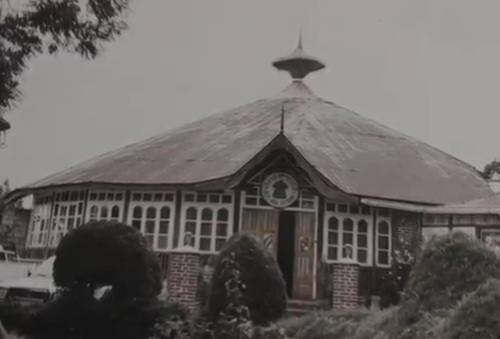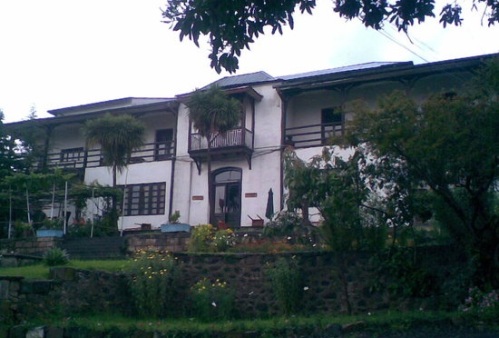WE’LL NEVER KNOW WHO OPENED the first Ethiopian restaurant in the world or when it opened: The ancient Axumites, c. 300-800 A.D., didn’t leave behind any cookbooks or menus, and Yekuno Amlak was too busy making himself emperor in 1270 and launching the Solomonic Dynasty to note where (or if) he stopped to eat.
But the world’s oldest Ethiopian restaurant is – where else? – in Ethiopia. We’re just not sure which one it is.
Two establishments currently claim the title: Addis Ababa restaurant, named for (and located in) the nation’s capital; and, just a few blocks away, the restaurant at the Itege Taitu Hotel, which gained international literary fame in 1938 when it appeared, as the Hotel Liberty, in Evelyn Waugh’s satirical novel Scoop.
I can’t find a precise date for the opening of Addis Ababa restaurant, but a very nice documentary (in Amharic) that I found in July 2017 says it’s 100 years old, which would mean it opened in 1917. That date could be ballpark or precise – no way to know. (Ethiopian cookbooks aren’t very good at precise measurements either.) The documentary offers a glimpse inside the restaurant today along with historic photos of its past. So even if you don’t understand Amharic, it’s worth watching (just above).
On the other hand, we know for sure that the Taitu Hotel – which had and still has a restaurant – opened in 1898 on the Ethiopian calendar, which is 1904-05 on the Western calendar. If the documentary about Addis Ababa restaurant is accurate, then Taitu Hotel’s restaurant wins.
Outside Addis Ababa, the restaurant’s sign proclaims its full name: Addis Ababa Y’Megeb Adarash. Megeb is the Amharic word for food, and adarash means hall or banquet hall, although such a place needn’t be affiliated with a restaurant or even the serving of food. Its building is more than a century old and has undergone some “personality changes” in the past century, my friend Menkir Tamrat tells me. It’s a couple blocks from the house where his wife grew up, and yet, until a trip home in October 2017, he’d never eaten there.


Addis Ababa restaurant as it looked decades ago and,
after some modernization, the way it looks now.
The building (see photos above) was constructed for Zewditu, the daughter of the great Ethiopian Emperor Menelik II, and a regional governor (dejazmach) named Webé, and its roof is shaped somewhat like a tukul, a thatched hut constructed by Ethiopians in non-urban regions. You’ll find some modern tables inside, but be prepared to have your meal around a mesob, the tall wicker basket onto which a round platter of food is placed.
The restaurant’s surrounding community is now known as Dejach Webé Sefer (“Dejach Sefer neighborhood”) or Webé Berha (Webé “light” or “bright”), a reference to the fact that in the early ‘50s, it was a lively place with dance bars – a sort of red light district. Asegedech Alamirew, reportedly a madam, operated the place before Emperor Haile Selassie turned it into a traditional restaurant to raise money to help poor women under a program championed by his wife, Empress Menen. Even today, some of the income from the restaurant helps support poor girls and women.

Addis Ababa Megeb Adarash –
that is, Addis Ababa Hall of Food.
Addis Ababa has no website, so Trip Adviser is the place to go for information and pictures. The restaurant’s reviews are generally very positive. The place seems to serve only “traditional” food – that is, the familiar dishes that we know as Ethiopian. Many restaurants in the country serve international cuisines, and even fast food like pizza, burgers and fried chicken.
“This was one of the best meals we had during our two-week trip around Ethiopia,” writes a visitor from Washington, D.C., on Trip Adviser. “Delicious mahabarawi platter, t’ej, and beer in a gorgeous newly built tukul interior, within walking distance of the Piazza. The service was attentive, with a chef/manager personally coming by to ask how we were enjoying our experience.” (The Piazza is a historic marketplace and tourist attraction in Addis Ababa.)
A Swiss patron has visited the place for seven years on trips to Ethiopia, and “the cuisine served there is always pleasant, if not inventive or revolutionary. It is authentic and the presence of a local clientele attests. The large round room offers a rather surprising frame, with its decor a little faded. Do not fail to be served a coffee according to the local ritual, with incense and popcorn – toddlers appreciate the latter more than injera sometimes.”
Says another visitor, from Spain: “The food is good, and the price is fair, but most remarkable is the building itself. It is over 100 years old and well preserved, which makes your lunch/dinner a unique experience. Definitely an interesting spot for an enjoyable meal.”
Then again, you can’t please everyone: “Absolutely terrible food experience I ever had and I am Ethiopian. They don’t know how to treat customers right. At all. Period.” Clearly, for this diner, አስደሳች እና አጥጋቢ ያልሆነ.***
The restaurant is located in the center of Addis Ababa and very close to the famous St. George Church. This area used to be known like Las Vegas, with bar after bar, glittering lights, prostitutes and dance clubs. But it’s much different and safer now, a draw for tourists, although not quite like it used to be.
The more contemporary Itege Taitu Hotel – itege, or ege, means empress – does have a website, as well as its own Wikipedia entry and a Facebook page. You can book a room online, and the most expensive ones they offer go for $55 a night, which would be about 1,500 Ethiopian birrs. It serves traditional cuisine, a daily vegan lunch buffet that includes non-Ethiopian dishes, and a menu of “slow food.” The website explains: “Our chefs craft to perfection traditional Ethiopian recipes as well as innovative combinations and international treats. Our permaculture garden is a symbol of our commitment towards a more sustainable way of preparing food.” The restaurant also offers catering. (At the end of this post, see a video look inside the hotel and its restaurant.)
In 2015, a fire severely damaged the hotel’s main building, but enough of its rooms survived to be rebuilt, and it’s still open today. The hotel itself gets mixed reviews on Trip Adviser, and there doesn’t seem to be a separate site for reviews of its cuisine, which patrons generally seem to like.


Two views of the Itege Taitu Hotel in Addis Ababa.
“The vegan buffet was excellent!” writes a satisfied (and practical) Los Angeleno. “There was a good variety of food: several stews, two types of injera, other breads, and many salads. My favorites were the yellow lentil stew, the cabbage, and the sauteed greens. The wait staff were constantly refilling items, so it seems like everything was relatively fresh. Because I was getting on a 20-plus-hour flight to Los Angeles that evening, I was worried about having stomach issues after eating. Everything was very clean, though, and I had no problems. I did avoid the raw salads, just in case.”
“Has a lot of character and pretty good food if you’re looking for authentic Ethiopian food or something a little more western,” says another American visitor. “I usually get the chicken fajitas. It’s more like a chicken burrito but good nonetheless.”
My Ethiopian-American friend Araya Yibrehu, who owned New York City’s first Ethiopian restaurant – Sheba, opened in 1979 – visited the hotel and its restaurant several times during a recent trip back home in 2017, and he speaks highly of the cuisine and the atmosphere.
He says the restaurant has the best ye’ts’om (vegetarian) dishes during the Lenten season, and it’s crowded during lunch time, with office workers who drive from all over the area. He also has seen quite a few young European and American tourists staying in the hotel, presumably because it’s less expensive than other lodging options. The restaurant has plenty of servers to bring drinks. There is no coffee ceremony in the restaurant itself, but you can go to another room after lunch for coffee and desserts.
“The hotel decor and ambiance has not changed a bit since the Emperor’s time,” Araya tells me. “As you walk in the main entrance of the hotel, nothing has changed since the ’70s. There is a huge old photo of Menilik and Taitu together. I never knew it was called Taitu Hotel in the past. We always called it Itege Hotel amongst friends and others. Even nowadays most people call it Itege Hotel.”
Still, Araya urges some caution in the vicinity of the hotel.
“Whether you go left or right of the hotel,” he says, “there are many bars with very loud music. The streets are crowded. The good thing is that once you go to the hotel, the atmosphere is so pleasant with its antiquity.” And the hotel is built atop a hill that gives you a view of the rest of modern Addis Ababa, like the Bole Airport, the parliament and hotels like the Sheraton and the Hilton.
Araya has also been to Addis Ababa Restaurant, and while he appreciates the place, he doesn’t praise its food as highly at the hotel’s cuisine. Addis Ababa is up the hill from the hotel, and it’s round inside, with lots of mesobs and berchumas (traditional wooden tables). It also has private rooms with tables and chairs.
“I remember during the ’70s it was a tourist attraction,” Araya says, “with busloads of people eating and drinking t’ej there. The locals couldn’t afford it then. I asked one of the workers recently if they get a lot of tourists like before, and he said no way. But I’m so happy it is still there.”
Harry Kloman
University of Pittsburgh
***Amharic words meaning “not pleasing and satisfying,” or more literally, “pleasing and satisfying it is not.”
(My thanks to Araya and Menkir for sharing memories and photos of the two restaurants.)
Here’s a look inside Itege Taitu Hotel.


Leave a comment